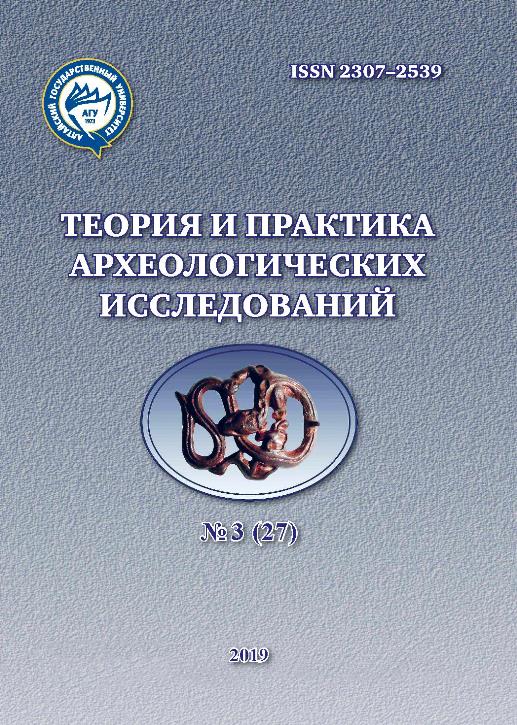3D MODELING OF ARCHAEOLOGICAL ARTIFACTS BY STRUCTURED LIGHT SCANNER
DOI:
https://doi.org/10.14258/tpai(2019)3(27).-07Keywords:
three-dimensional modeling, 3D scanning, structured light scanners, archaeological objects, scalingAbstract
Currently, 3D modeling of archaeological artifacts is the most actively developing science area in archaeology. It serves both for visualization of objects of the archaeological heritage, and for verifiable scientific research at a previously inaccessible level of detail. The proposed article provides a universal method for scanning archaeological artifacts using a structured light scanner. As a result of scan applying, you can get a scaled model of an archaeological artifact that fully corresponds to the original. Using the example of threedimensional images of stone tools, basic recommendations are given for scanning archaeological artifacts of various colors and sizes. Examples of the most common errors that occur during scanning as a result of incorrect equipment settings or due to the physical properties of the scanned objects are given. Error correction algorithms can be used for any scanning devices and scanning any types of artifacts. The proposed article can be used as a teaching tool for learning to scan archaeological objects using scanners of structured illumination.
Downloads
References
Vavulin M.V., Zajceva O.V., Pushkarev A.A. Metodika i praktika 3D skanirovaniya raznotipnyh arheologicheskih artefaktov [Methods and Practice of 3D Scanning of Different Types of Archaeological Artifacts]. Sibirskie istoricheskie issledovaniya [Siberian Historical Studies]. 2014. №4. Pp. 21–37.
Zotkina L.V., Kovalev V.S., Shalagina A.V. Vozmozhnosti i perspektivy primeneniya trekhmernoj vizualizacii kak instrumenta analiza v arheologii [Opportunities and Prospects for the Use of Three-Dimensional Visualization as an Analysis Tool in Archaeology]. Nauchnaya vizualizaciya [Scientific Visualization]. 2018. Vol. 10, №4. Pp. 172–190.
Pavlenok G.D., Shalagina A.V., Shnajder S.V., Kovalev V.S., Kazakov V.V., Bomann M. Sovremennaya metodika izucheniya arheologicheskih ob”ektov vo Francii: opyt uchastiya v nauchnyh seminarah i polevyh rabotah v provincii Dordon’ (yugo-zapad Francii) [Modern Methods of Studying Archaeological Objects in France: the Experience of Participation in Scientific Seminars and Field Work in the Province of Dordogne (south-west France)]. Universum Humanitarium. 2016. №2 (3). Pp. 23–37.
Shalagina A.V., Shnajder S.V., Kolobova K.A. Vozmozhnosti primeneniya 3-D skanirovaniya i analiza posledovatel’nosti skolov (scar pattern analysis) pri izuchenii dvustoronneobrabotannyh orudij [Possibilities for the Use of 3-D Scanning and Analysis of the Sequence of Scars (scar pattern analysis) in the Study of Two-Sided Tools]. Trudy V (XXI) Vserossijskogo arheologicheskogo s”ezda v Barnaule – Belokurihe [Proceedings of the V (XXI) All-Russian Archaeological Congress in Barnaul – Belokurikha]. Barnaul : Azbuka, 2017. Vol. 1. Pp. 120–124.
DeReu J., Plets G., Verhoeven G., DeSmedt P., Bats M., Cherretté B., De Maeyer W., Deconynck J., Herremans D., Laloo P., Van Meirvenne M., De Clercq W. Towards a Three-Dimensional Cost-Effective Registration of the Archaeological Heritage // Journal of Archaeological Science. 2013. Vol. 40, Issue 2. Рp. 1108–1121.
Gajski D., Solter A., Gašparović M. Applications of Macro Photogrammetry in Archaeology // The International Archives of the Photogrammetry, Remote Sensing and Spatial Information Sciences. XXIII ISPRS Congress, 12–19 July 2016, Prague, Czech Republic, 2016. Vol. XLI-B5. Рp. 263–266. DOI:10.5194/ isprsarchives-XLI-B5-263-2016.
Garstki D. Virtual Representation: the Production of 3D Digital Artifacts // Archaeological Method Theory. 2017. №24. Рp. 726–750. DOI: 10.1007/s10816-016-9285-z.
Grosman L., Smikt O., Smilansky U. On the Application of 3-D Scanning Technology for the Documentation and Typology of Lithic Artifacts // Journal of Archaeological Science. 2008. №35 (12). Р. 3101–3110.
Herzlinger G., Goren-Inbar N., Grosman L. A New Method for 3D Geometric Morphometric Shape Analysis: The Case Study of Handaxe Knapping Skill // Journal of Archaeological Science Reports. 2017. №14. Рp. 163–173. doi:10.1016/j.jasrep.2017.05.013.
Morales J.I., Soto M., Lorenzo C., Vergès J.M. The Evolution and Stability of Stone Tools: The Effects of Different Mobility Scenarios in Tool Reduction and Shape Features // Journal of Archaeological Science. 2015. №3. Рp. 295–305.


